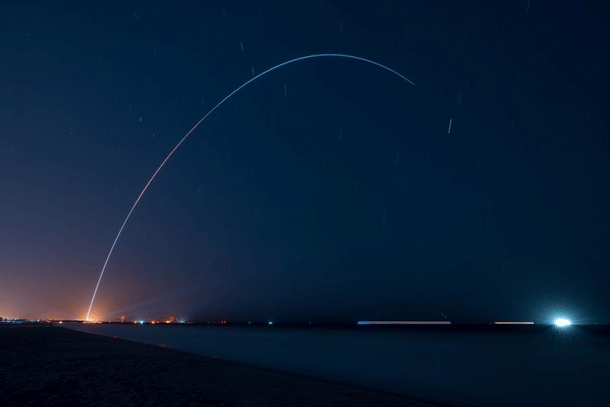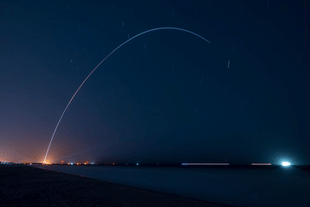Science
Third Time’s A Charm: World’s First 3D-Printed Rocket Lifted Off Into The Night Sky, Though Fell Short Of Orbit, In “Huge Win” For Relativity Space
Karan Kamble
Mar 23, 2023, 08:52 PM | Updated 08:56 PM IST
Save & read from anywhere!
Bookmark stories for easy access on any device or the Swarajya app.


Third time’s a charm, we hoped in conclusion to our story on the world’s first 3D-printed rocket failing to get off the ground on two occasions.
On 22 March (eastern time), in its third attempt, the innovatively made launch vehicle strode towards the skies, marking many firsts and, most importantly, proving that the innovative ways of the American space company behind the rocket, Relativity Space, are working.
The Terran 1 rocket, on its maiden mission called “GLHF” — short for “Good Luck, Have Fun,” took off from Launch Complex 16 at Cape Canaveral Air Force Station, Florida.
Along the way, it crossed some key mission objectives — achieving main engine cut-off and stage separation, but also, perhaps most importantly, surviving and gathering data at Max-Q, one of the most demanding phases of flight.
“We successfully made it through Max-Q, the highest stress state on our printed structures. This is the biggest proof point for our novel additive manufacturing approach,” Relativity said in a tweet.
The full possibility of the mission extended right up to the rocket reaching orbit. But that did not happen after an anomaly cropped up in the second stage.
Still, Relativity was happy with crossing the mission milestones that it did. It will now use data from the flight to further improve their rockets, including the bigger Terran R.
Terran R is the world’s first fully reusable, entirely 3D printed rocket. It is a medium-to-heavy-payload reusable launch vehicle that will be capable of launching over 20,000 kg to LEO.
Terran 1 is a “pathfinder product” for Terran R.
The lessons learnt from the Terran 1 debut mission, which involved a prototype vehicle not carrying a customer payload, will also enable Relativity to improve their software-driven approach to manufacturing.
Software-defined aerospace manufacturing might just be the way to go in the future.
Launch Day
Despite the success, the launch night wasn’t uneventful.
Relativity put the clock on hold at T-25 minutes when the upper-level wind shear was found to be outside of stage-one gimbal limits, and, in addition, there was a boat in the range which had to be cleared out of the hazard zone.
The new launch time was set for 11:05 pm (eastern time), comfortably within the prescribed launch window of 10 pm to 1 am. But then, a second hold at T-10 minutes pushed the launch time to 11:25 pm.
The rocket did take off at this updated time and progressed successfully through several stages of flight.
Earlier, Relativity had made launch attempts on 8 March and 11 March.
“On our first launch attempt on March 8th, we had a ground system issue that prevented us from getting our liquid oxygen temperatures as cold as we need for launch. So, after trying to work through that, we ultimately had to scrub for the day because we couldn’t hit what we call our launch commit criteria or LCCs on those temperatures,” James Harris, Chief Engineer for Terran 1, explained on a launch day video.
After they fixed the ground system issue, Relativity was ready for their next launch attempt on 11 March. The Terran 1 rocket in its second try came very close to launching, with the flight being called off within a second of launch time — T-0.5 seconds, to be precise.
“At T-0.5, we check our last set of launch commit criteria. And what happened that time is, we tripped a criteria on what was calculated as the leak rate. We were able to find the cause of that, and the automation, and fix it quickly, and turn around into another attempt,” Harris said.
Unfortunately, the rocket was held back yet again because the fuel tank on stage two was outside of pressure bounds.
Yet, going all the way down to T-0.5 seconds, including running the engines, had given Relativity data through the pre-launch stages to confidently march on ahead with the third, and what turned out to be the final and successful, attempt to launch GLHF.
Relativity Space co-founder and chief executive officer Tim Ellis was stoked to see the live launch of a rocket with his own eyes.
“I told myself when I founded @relativityspace that my first launch viewing would be our own rocket, as motivation to make it there, and here we are. What a sight to behold, feel, and hear - indescribably awe inspiring,” Ellis wrote in a tweet.
Words of support and congratulations came in from a couple of space companies based in California and on to great things themselves.
Space launch company Astra tweeted: “Congratulations and great progress on your first test flight!”
“Congrats on first flight, team! Celebrate well tonight and enjoy your wealth of new data tomorrow,” said Rocket Lab.
Getting to orbit will very likely be Relativity Space’s next target.
Relativity’s Rockets
Terran 1 is a two-stage, expendable rocket, standing 110-foot (ft) tall and 7.5-ft wide.
It can carry a maximum of 900 kilograms (kg) to sun synchronous orbit and a maximum of 1,250 kg to low-Earth orbit (LEO). A dedicated mission on the rocket would cost $12 million.
The rocket is 85 per cent 3D-printed by mass. (Relativity is working to lift that figure up to 95 per cent.) Not only is the structure 3D printed, but so are the engines.
Terran 1 has nine 3D printed Aeon engines on its first stage and one Aeon Vac on its second stage.
The engines use liquid oxygen (LOX) and liquid natural gas (LNG), which, the startup believes, are not only the best-suited for rocket propulsion, but also for reusability. That’s not all — it’s the easiest to eventually make on Mars, too.
It’s the fuel of choice even for the Vulcan rocket of the prominent American space launch service provider United Launch Alliance.
Remarkably, Relativity can turn raw material into Terran 1, and also Terran R, within just 60 days — integrating artificial intelligence (AI), robotics, and autonomous manufacturing technology.
The Terran rockets use 100 times fewer parts as compared to a traditional rocket, the company says.
Relativity uses Stargate, their metal 3D printer with AI-driven controls, to create its Terran rockets. Stargate is part of the company’s “Factory of the Future,” an aerospace platform to automate rocket manufacturing.
According to Relativity, they are “an application-layer 3D printing company that is starting with rockets, and will extend its Factory of the Future to all of aerospace.”
It has been quite a journey for Relativity — the company started out as an idea on a Starbucks receipt and has now crossed the milestone of a successful debut launch.
This is still only the beginning for a company that aims to eventually build humanity’s industrial base on Mars.
Ellis has said they already have “$1.65 billion in customer launch contracts,” overwhelmingly for the Terran R, and that there are “billions more in our pipeline.”
“Medium-heavy lift is clearly where the biggest market opportunity is for the remaining decade, with a massive launch shortage in this payload class underway,” the Relativity chief wrote in a tweet.
Terran R is set for a debut launch from Cape Canaveral in 2024.
Karan Kamble writes on science and technology. He occasionally wears the hat of a video anchor for Swarajya's online video programmes.




